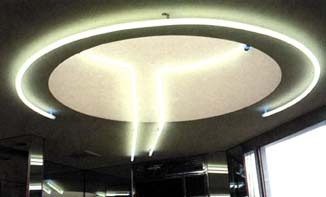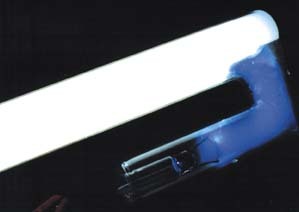Many people associate neon solely with signage and, therefore, rarely realize that cold cathode or "big tube" neon, is a versatile lightsource that’s used in numerous applications. This month, I’ll discuss how lighting with cold-cathode or custom-made, hot-cathode lamps can improve, not only the appearance of a building, but also a neon shop’s business.
Size matters
In the American, as well as Middle and Far East markets, "neon" and "cold cathode" are regarded as two completely different components. Physically, they’re equal in all aspects, excluding size. Although a lighting system’s primary purpose is to generate a high amount of light efficiently, a neon sign’s main function is to transmit a message via light. However, to generate significant light, the amount of energy required must be several times greater than what is needed to make a neon tube "appear lit" in a sign.
For all components of the "big neon tube" or "cold-cathode" lighting system (Fig. 1), the ability to transform large amounts of electrical energy leads to a required minimum size to achieve a long lifetime. You can generate huge amounts of light by overloading small components, but then, lifetime will be short.
To handle big-sized glasswork and processing, special skills and tools are required (see ST, May and June 2001, pages 44 and 24, respectively). Large, architectural, cold-cathode installations (Fig. 2), which might comprise several miles of tubing for a single building, typically include complex dimming or animating systems. In contrast to other means of lighting, cold cathode can be dimmed or flashed without limits (Figs. 3a and 3b).
Specifying cold cathode
Advertisement
Because many parameters are involved, specifying a cold-cathode installation isn’t as easy as specifying a simple neon sign. Keep in mind that lighting design is a profession that requires an undergraduate engineering degree.
A simplified sample calculation may only show how to approach such a task. Thus, interested readers should reference lighting-engineering literature prior to estimating even a small installation.
Properly manufactured and installed cold-cathode applications can give more than 30,000 hours of trouble-free service; they have a much higher efficiency than halogen or LED lighting; and they offer the widest color palette of all light sources. (Today, clients can choose from nearly 20 different whites, plus all colors common in neon signs.) Such aspects shouldn’t be neglected when discussing lighting-system costs with potential clients.
Sample calculation
Note: For correct units, we must use the International System of Units (SI) with metric dimensions in this calculation. Some old lighting units still common in the United States can’t be converted without applying complex mathematics. Thus, the SI system will be used.
A textile quality-control room of approximately 33 x 100 ft. (10 * 30 meters) requires an illumination level of 500 lux in the work area at a high-color rendering factor.
Advertisement
For simplicity, we’ll assume the lighting is horizontally mounted tubing suspended from the ceiling with a reflector, which reflects all light towards the ceiling for indirect, shadow-free illumination. The ceiling has a reflection factor of 75%; the walls’ reflection factor is 50%. For the given room dimensions and reflection coefficients of ceiling and walls, we obtain an approximate light-usage factor of 0.39.
For light loss caused by dirt and tube aging, we’ll assume a 50% light loss. In case the walls and ceiling would reflect light 100%, the total 300 sq. meters would require a total luminous flux of 300 meters squared x 500 lumen/m2 = 150,000 lumen. As a result of the usage factor and safety margin, the total luminous flux required is 150,000 lumen/(0.39 x 0.5) = 150,000/0.195 = 769,230 lumen.
The tubes are to be installed in three rows of fixtures along the room, giving a total linear fixture length of 3 x 30 meters = 90 meters. For a chosen light color with a color rendering index of 0.9, the manufacturer specifies, for a 25mm tube, a luminous output of 1,700 lumens per meter per 100mA of operating current. For a single tube row in each fixture, this would require a linear lumen output of 769,230 lumen/90 meters (8,547 lumens per meter), which would require an operating current of 502mA for 90 meters of tubing to achieve the light output required — impossible to realize with stock items.
If we install five rows of tubing in each reflector fixture, we’ll achieve 8,500 lumens per meter at 100mA. With five rows of cold cathode in each reflector, the installation will consist of a linear length of 450 meters, achieved with 188, 8-ft. units, which would require a total transformer voltage of 163,860V. Thus, we’ll select 14 high-power-factor transformers, each with a voltage of 12kV (power 778W). The total load of the electrical supply is 10,892W. Note that the 8-ft. units measuring 25mm diameter must be fitted with 120mA-type electrodes.
Hot cathode runs cooler
If a custom-made lighting installation isn’t going to be dimmed, or only occasionally switched on and off, it might be worth considering hot-cathode slimline lighting instead of cold-cathode tubing to save energy. For cold cathode, every pair of electrodes requires a voltage drop of approximately 300V. Using an operating current of 120mA, the power lost in each pair of electrodes — which is mainly transformed into heat — is approximately 36W per electrode pair.
Advertisement
In contrast, hot-cathode filament electrodes (Fig. 4) have a voltage drop of approximately 12V to 16V, which results in a power loss of 1.92W per pair. Less power loss for the hot-cathode electrode will generate less heat — or, the hot-cathode system will operate at a cooler level than the cold-cathode system.
At first, the savings appear insignificant. Let’s calculate our sample room: 34W loss x 188 tubes = 6,392W. Assume an operating time of 10 hours/day = 63.9kWh/day, at 15 cents for each kilowatt-hour. Using custom-made, hot-cathode lamps will save $9.50/day in operating electricity costs.
Now imagine a big shopping mall, with roughly 1,500 total installed tubes. The electrode losses accumulate to 54kW for cold cathode and only 2,880W if custom-made, hot-cathode slimline lamps are installed at the same light output. This is no longer peanuts! The energy savings exceed the initial higher price of the tubing. It needs to be processed in a special oven, and its lifetime greatly depends on the operating conditions that occur between 8,000 and 25,000 hours, so its lifetime is much shorter than cold cathode.
In conclusion, we’ve discovered that custom-made, cold- or hot-cathode slimline lighting systems can meet almost every architectural and lighting demand, while providing one of the most effective, economical lighting solutions. For this reason, the demand for custom-made tubular lighting will rise and so will business for neon shops specializing in the "big tube game."



 Photo Gallery1 week ago
Photo Gallery1 week ago
 Ask Signs of the Times1 week ago
Ask Signs of the Times1 week ago
 Paula Fargo6 days ago
Paula Fargo6 days ago
 Real Deal3 days ago
Real Deal3 days ago
 Benchmarks2 weeks ago
Benchmarks2 weeks ago
 Photo Gallery6 days ago
Photo Gallery6 days ago
 Women in Signs1 week ago
Women in Signs1 week ago
 Women in Signs1 week ago
Women in Signs1 week ago














